= Pyrrhocactus catamarcensis (Speg.) Backeb.
Kaktus-ABC [Backeb. & Knuth] 262. 1936 [12 Feb 1936] Backeb., F.M.Knuth
Accepted Scientific Name: Eriosyce strausiana (K.Schum.) Katt.
Eriosyce (Cactac.) gen. revis. & ampl. (Succ. Pl. Res., 1) 117 (1994)
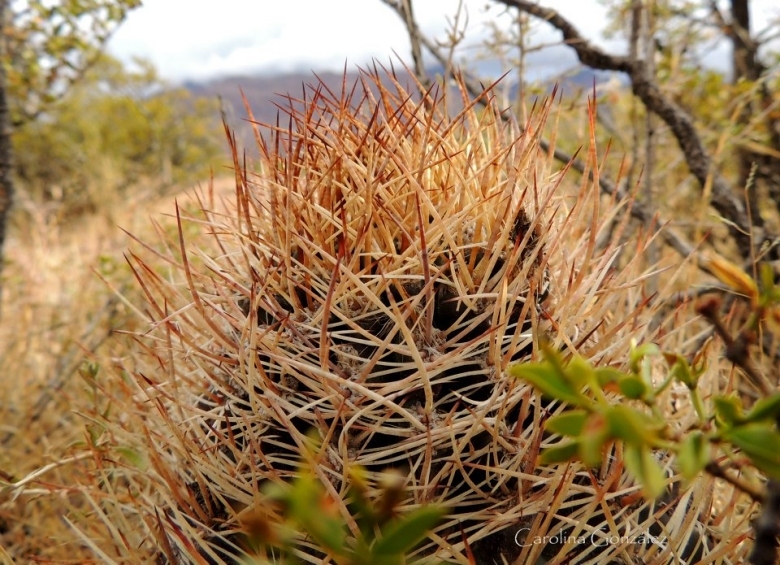
Echinocactus catamarcensis var. obscura (Pyrrhocactus catamarcensis) Photo by: Carolina González
Pale spines form in habitat (Mendoza province, Argentina).
Synonyms:
See all synonyms of Eriosyce strausiana
Description: Pyrrhocactus catamarcensisSN|18140]]SN|18140]] (firstly described as Echinocactus catamarcensisSN|31031]]SN|42]] by Spegazzini in 1905) is a local or morphological form of the widespread and variable Eriosyce strausianaSN|18]]SN|18]]. It is a solitary or slowly clumping cactus with very strong spines varying in colour from creamy-white to very purple-black. The dark-coloured form, with odd bluish grey-black spines (appearing red when seen against the light), was at first distinguished as Echinocactus catamarcensis var. obscuraSN|31030]]SN|31030]] Speg., while the pale-coloured form was called Echinocactus catamarcensis var. pallidaSN|42]]SN|31031]] Speg.. However the different colour forms of Pyrrhocactus catamarcensisSN|18140]]SN|18140]], appear to fall within the natural variation of Eriosyce strausianaSN|18]]SN|18]] and it should be fully synonymized with the latter.
Bibliography: Major references and further lectures
1) Catálogo de las Plantas Vasculares “Pyrrhocactus catamarcensis (Speg.) F. Ritter” Instituto de Botánica Darwinion - IBODA 2014 web <http://www2.darwin.edu.ar>
2) Kiesling, R. "Cactaceae Fl. San Juan" Volume 2, pages 161-193 2003.
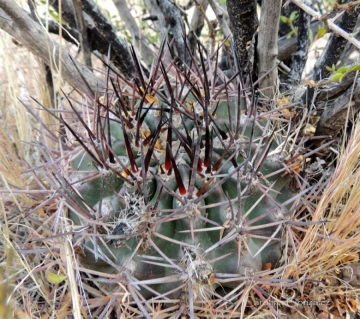 Dark spine form in habitat (Mendoza province, Argentina). (Pyrrhocactus catamarcensis) Photo by: Carolina González
Dark spine form in habitat (Mendoza province, Argentina). (Pyrrhocactus catamarcensis) Photo by: Carolina González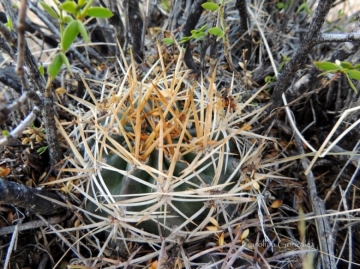 Pale spines form in habitat (Mendoza province, Argentina). (Pyrrhocactus catamarcensis) Photo by: Carolina González
Pale spines form in habitat (Mendoza province, Argentina). (Pyrrhocactus catamarcensis) Photo by: Carolina González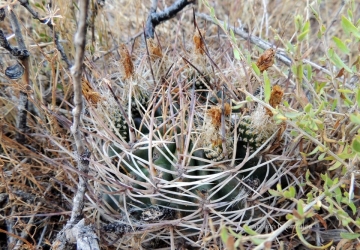 In habitat (Mendoza province, Argentina). (Pyrrhocactus catamarcensis) Photo by: Carolina González
In habitat (Mendoza province, Argentina). (Pyrrhocactus catamarcensis) Photo by: Carolina González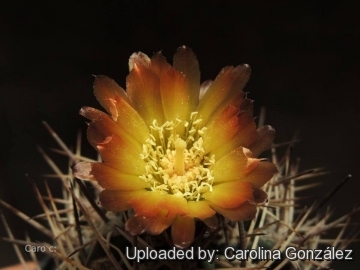 Echinocactus catamarcensis var. obscura (Pyrrhocactus catamarcensis) Photo by: Carolina González
Echinocactus catamarcensis var. obscura (Pyrrhocactus catamarcensis) Photo by: Carolina GonzálezCultivation and Propagation: This slow growing cactus is kept for the beauty of its form and flowers. It is a summer grower species. Easy to cultivate but somewhat rot prone if kept in a non ventilated place, especially after planting.
Growth rate: Slow-growing and very long-lived. This cactus continues to be, a particular prize among collectors.
Soils: It likes very porous mineral cactus mix soil, but can become too elongated if compost is too rich.
Repotting: This plant needs plenty of space for its roots, repotting should be done every other year or when the it has outgrown its pot. Use pot with good drainage.
Watering: Needs moderate in summer, but do not overwater (extremely rot prone), keep dry in winter at a minimum temperature of 0°C.
Fertilization: Feed with a high potassium fertilizer in summer.
Hardiness: Reputedly resistant to frost if kept on the dry side prior to, and during, cold weather (hardy to -12 C ° C, or less for short periods), but for safe cultivation it is best to avoid freezing temperatures. It need a very good ventilation.
Exposition: The plant tolerates extremely bright situations. Blasting full sun encourages flowering and heavy spine production.
Pests & diseases: It may be attractive to a variety of insects, but plants in good condition should be nearly pest-free, particularly if they are grown in a mineral potting-mix, with good exposure and ventilation. Nonetheless, there are several pests to watch for:
- Red spiders: Red spiders may be effectively rubbed up by watering the plants from above.
- Mealy bugs: Mealy bugs occasionally develop aerial into the new growth among the wool with disfiguring results, but the worst types develop underground on the roots and are invisible except by their effects.
- Scales: Scales are rarely a problem.
- Rot: This species is not easy and accommodating, often suffer of cryptogamic diseases. The main problem with Argentinian pyrrhocacti is the scorching type disease on the apex. This disease seems to be worse on Eriosyce strausianaSN|18]]SN|18]] than the others species, it scorches just some plants, but it doesn't seem to be contagious. Takes a while but they can grow out of it. Root rot is a serious problem with pyrrhocacti if the plants are not watered and “aired” correctly. If they are not, fungicides won't help all that much.
Propagation: Seed or grafting. The seeds germinate with extreme difficulty and a low rate of success. Seedlings did not do well either, and some die each year.
More...














